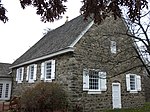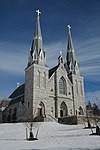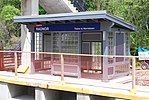Conestoga Road
1684 establishments in PennsylvaniaAuto trails in the United StatesInfobox road instances in PennsylvaniaInfobox road maps tracking categoryRoads in Pennsylvania ... and 1 more
Use mdy dates from March 2020
Conestoga Road, also called "Conestoga Pike" or "Allegheny Path", is a historic road dating from at least 1684 in what is now the U.S. state of Pennsylvania. It starts as Allegheny Avenue in Philadelphia to the west through Morgantown, Harrisburg and west towards the Allegheny Valley. Originally the road was a walking path that was 12-18 inches in width. During the era of horse drawn Conestoga wagons, the road was widened. During most of its existence as a turnpike, it served as the alternate route to the Lancaster Pike and Ridge Road (present day Pennsylvania Route 23). The route gained notoriety as the shortest route from Philadelphia to Harrisburg.
Excerpt from the Wikipedia article Conestoga Road (License: CC BY-SA 3.0, Authors).Conestoga Road
Conestoga Road, Radnor Township
Geographical coordinates (GPS) Address Nearby Places Show on map
Geographical coordinates (GPS)
| Latitude | Longitude |
|---|---|
| N 40.0288 ° | E -75.3592 ° |
Address
Conestoga Road 662
19085 Radnor Township
Pennsylvania, United States
Open on Google Maps







